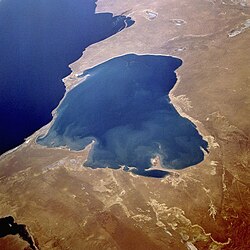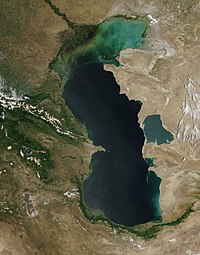Garabogazköl Contents Salt In popular culture References External links Navigation menu41°21′07″N 53°35′43″E / 41.35194°N 53.59528°E / 41.35194; 53.5952841°21′07″N 53°35′43″E / 41.35194°N 53.59528°E / 41.35194; 53.59528Kara-Bogaz-Gol Bay: Physical and Chemical EvolutionLake Basin Management Initiative - The Caspian SeaEnvironmental Resources and Constraints in the Former Soviet Republics0008-5006Google Maps Detail showing the current in the strait
Bodies of water of TurkmenistanCaspian SeaLagoons of AsiaBalkan RegionBays of the Caspian Sea
TurkmenTurkmenistanlagoonCaspian Seasurface arearidgeTurkmen languagewatervolumebayGarabogazsalinitythe world's oceansDead Seaevaporitesocialist-realistKonstantin Paustovsky
| Garabogazköl | |
|---|---|
| Kara-Bogaz-Gol | |
 Kara-Bogaz Gol from space, September 1995 | |
 Garabogazköl | |
| Location | Turkmenistan |
| Coordinates | 41°21′07″N 53°35′43″E / 41.35194°N 53.59528°E / 41.35194; 53.59528Coordinates: 41°21′07″N 53°35′43″E / 41.35194°N 53.59528°E / 41.35194; 53.59528 |
| Native name | Кара-Богаз-Гол (Turkmen) |
The Garabogazköl Aylagy or Kara-Bogaz-Gol (Turkmen: Кара-Богаз-Гол, lit. black (or mighty) strait lake) is a shallow inundated depression in the northwestern corner of Turkmenistan.[1] It forms a lagoon of the Caspian Sea with a surface area of about 18,000 km2 (6,900 sq mi).[2] It is separated from the Caspian Sea proper, which lies immediately to the west, by a narrow, rocky ridge having a very narrow opening in the rock through which the Caspian waters flow, cascading down into Garabogazköl, leading to the Turkmen language name of the bay, "Mighty Strait Lake". The water volume of the bay fluctuates seasonally with the Caspian Sea; at times it becomes a large bay of the Caspian Sea, while at other times its water level drops drastically.
The city of Garabogaz (formerly Bekdaş) lies on the ridge, about 50 km (31 mi) north of the channel between the main Caspian basin and the Garabogazköl lagoon. The town has a population of about 10,000.
Contents
1 Salt
2 In popular culture
3 References
4 External links
Salt
The salinity of the bay is about 35%, compared to the Caspian Sea's 1.2%,[3] and 3–4% for the bulk of the world's oceans. Because of the exceptionally high salinity, comparable to the Dead Sea, it has practically no marine vegetation. Large evaporite, mostly salt deposits accumulated at the south shore were harvested by the local population since the 1920s, but in the 1930s manual collection stopped and the industry shifted northwest to its present center near Garabogaz. From the 1950s on, ground water was pumped from levels lower than the bay itself, yielding more valuable types of salts. In 1963 construction began at Garabogaz on a modern plant for increased production of salines, all the year round and independently of natural evaporation. This plant was completed in 1973.
@media all and (max-width:720px).mw-parser-output .tmulti>.thumbinnerwidth:100%!important;max-width:none!important.mw-parser-output .tmulti .tsinglefloat:none!important;max-width:none!important;width:100%!important;text-align:center


In March 1980, the barrier to the Caspian was blocked, due to concerns evaporation was accelerating a fall in Caspian Sea level, reducing water levels.[2] The resulting "salt bowl" caused widespread problems of blowing salt,[4] reportedly poisoning the soil and causing health problems for hundreds of kilometers downwind to the east. In 1984 the lake was completely dry. In June 1992, when Caspian Sea levels were rising again, the barrier was breached, allowing Caspian water to again refill Garabogazköl. The remnants of the breached dam can be seen in the satellite photo of the inlet, near the Caspian Sea entrance.

Garabogazköl (right) visible from a bridge on a barrier separating it from the Caspian Sea (left)
In popular culture
The bay is also the subject of the "socialist-realist" writer Konstantin Paustovsky's, 1932 book Kara-Bogaz, which praised the development of the salt industry in the area by the Soviet government in the 1930s.[5][6][7]
References
^ "Turkmenistan". Geo-Data: The World Geographical Encyclopedia. 2003 – via HighBeam Research. (Subscription required (help)). Missing or empty|url=(help).mw-parser-output cite.citationfont-style:inherit.mw-parser-output .citation qquotes:"""""""'""'".mw-parser-output .citation .cs1-lock-free abackground:url("//upload.wikimedia.org/wikipedia/commons/thumb/6/65/Lock-green.svg/9px-Lock-green.svg.png")no-repeat;background-position:right .1em center.mw-parser-output .citation .cs1-lock-limited a,.mw-parser-output .citation .cs1-lock-registration abackground:url("//upload.wikimedia.org/wikipedia/commons/thumb/d/d6/Lock-gray-alt-2.svg/9px-Lock-gray-alt-2.svg.png")no-repeat;background-position:right .1em center.mw-parser-output .citation .cs1-lock-subscription abackground:url("//upload.wikimedia.org/wikipedia/commons/thumb/a/aa/Lock-red-alt-2.svg/9px-Lock-red-alt-2.svg.png")no-repeat;background-position:right .1em center.mw-parser-output .cs1-subscription,.mw-parser-output .cs1-registrationcolor:#555.mw-parser-output .cs1-subscription span,.mw-parser-output .cs1-registration spanborder-bottom:1px dotted;cursor:help.mw-parser-output .cs1-ws-icon abackground:url("//upload.wikimedia.org/wikipedia/commons/thumb/4/4c/Wikisource-logo.svg/12px-Wikisource-logo.svg.png")no-repeat;background-position:right .1em center.mw-parser-output code.cs1-codecolor:inherit;background:inherit;border:inherit;padding:inherit.mw-parser-output .cs1-hidden-errordisplay:none;font-size:100%.mw-parser-output .cs1-visible-errorfont-size:100%.mw-parser-output .cs1-maintdisplay:none;color:#33aa33;margin-left:0.3em.mw-parser-output .cs1-subscription,.mw-parser-output .cs1-registration,.mw-parser-output .cs1-formatfont-size:95%.mw-parser-output .cs1-kern-left,.mw-parser-output .cs1-kern-wl-leftpadding-left:0.2em.mw-parser-output .cs1-kern-right,.mw-parser-output .cs1-kern-wl-rightpadding-right:0.2em
^ ab Kosarev, Aleksey; Kostianoy, Andrey; Zonn, Igor (2008-11-02). Kara-Bogaz-Gol Bay: Physical and Chemical Evolution (Report).
^ Aladin, Nicolai; Plotnikov, Igor (2004). Lake Basin Management Initiative - The Caspian Sea (PDF) (Report).
^ Micklin, Philip P. Environmental Resources and Constraints in the Former Soviet Republics (1994). The National Council for Soviet and Eastern European Research. Page 9.
^ Konstantin Paustovsky (1977) The Black Gulf, Hyperion Press, Westport, Conn.
ISBN 978-0-88355-411-1
^ Priestland, David (October 1, 2010). "Engineers of the Soul". History Today – via Highbeam Research.
^ Ruch, Julie Ella (Spring 2013). "Engineers of the Soul: The Grandiose Propaganda of Stalin's Russia". Canadian Slavonic Papers. 55 (1/2): 246–247. ISSN 0008-5006 – via ProQuest Research Library. (Subscription required (help)).
External links
| Wikimedia Commons has media related to Category:Kara bogaz gol. |
- Google Maps Detail showing the current in the strait